Stability Evaluation Method of Hole Wall for Bored Pile under Blasting Impact
Abstract
:1. Introduction
2. Stability Analysis of Hole Wall under Static Load
3. Stability Analysis of Hole Wall under Blasting Impact
4. Case Study
5. Experimental Verification
6. Conclusions
Author Contributions
Funding
Institutional Review Board Statement
Informed Consent Statement
Data Availability Statement
Conflicts of Interest
Appendix A
References
- Tian, Y.; Zhou, Z.; Dong, Y.; Wang, K.; Feng, H. Study on the value of side friction of bored pile in loess area considering the influence of length diameter ratio. Arab. J. Geosci. 2021, 14, 2067. [Google Scholar] [CrossRef]
- Moayedi, H.; Hayati, S. Applicability of a CPT-based neural network solution in predicting load-settlement responses of bored pile. Int. J. Geomech. 2018, 18, 06018009. [Google Scholar] [CrossRef]
- Zhou, Z.; Zhang, Z.; Chen, C.; Xu, F.; Xu, T.; Zhu, L.; Liu, T. Application of load transfer method for bored pile in loess area. Eur. J. Environ. Civ. Eng. 2021, 1, 1–19. [Google Scholar] [CrossRef]
- Zhang, Q.-Q.; Feng, R.-F.; Yu, Y.-L.; Liu, S.-W.; Qian, J.-G. Simplified approach for prediction of nonlinear response of bored pile embedded in sand. Soils Found. 2019, 59, 1562–1578. [Google Scholar] [CrossRef]
- Ng, C.W.W.; Zhang, L.; Nip, D.C.N. Response of laterally loaded large-diameter bored pile groups. J. Geotech. Geoenviron. Eng. 2001, 127, 658–669. [Google Scholar] [CrossRef]
- Gao, L.; Han, C.; Xu, Z.; Jin, Y.; Yan, J. Experimental Study on Deformation Monitoring of Bored Pile Based on BOTDR. Appl. Sci. 2019, 9, 2435. [Google Scholar] [CrossRef] [Green Version]
- Wang, Y.; Zhang, G.; Hu, Q. Analysis of stability of bored pile holewall. Chin. J. Rock Mech. Eng. 2011, 30, 3281–3287. [Google Scholar]
- Wu, Y.H.; Zhou, Z.; Chen, W.Q.; Liu, S.Y.; Zhang, B.C.; Huang, H.F. Research on Construction Technology of cast-in-situ bored pile under Complex Geological Conditions[C]//IOP Conference Series: Earth and Environmental Science. IOP Publ. 2020, 510, 052089. [Google Scholar]
- Xiulei, D.Y.Y. Bored Pile of Bridge-Prevention and Solution of Hole Collapse. For. Sci. Technol. Inf. 2002, 4, 15–19. [Google Scholar]
- Duan, Z.D.; Duan, Y.P.; Yan, P.W. Influencing factors Analysis of Stability of Hole wall of bored Pile in Seasonal Frozen Ground in the West of China. In Applied Mechanics and Materials; Trans Tech Publications Ltd.: Uetikon-Zuerich, Switzerland, 2013; Volume 256, pp. 441–444. [Google Scholar]
- Marlow, P.; Webber, S.; Mikula, P.A.; Lee, M. Bored reinforced piles for raisebore support: Four case studies, and guidelines developed from lessons learnt. Min. Technol. 2013, 122, 159–165. [Google Scholar] [CrossRef]
- Yin, M.Z. A Pile Foundation problem: Collapse of soil in pile bore holes. In Applied Mechanics and Materials; Trans Tech Publications Ltd.: Uetikon-Zuerich, Switzerland, 2015; Volume 744, pp. 413–416. [Google Scholar]
- Bradley, W.B. Mathematical Stress cloud, Strss cloud can Predict borehole failure. Oil Gas J. 1979, 79, 92–102. [Google Scholar]
- Roegiers, J.C. Well Modeling: An overview. Oil Gas Sci. Technol. 2002, 57, 569–577. [Google Scholar] [CrossRef]
- Li, J.P.; Chen, M.; Liang, F.Y. Analysis of Stability of Super-Long Bored Pile Considering Resistance of Soil on the Side of Pile. In Deep Foundations and Geotechnical In Situ Testing; Geotechnical Special Publication: Shanghai, China, 2010; pp. 161–168. [Google Scholar]
- Shi, C. Stability Analysis of Bored Pile Hole Wall and Application of Post Grouting; Southeast University: Nanjing, China, 2006. (In Chinese) [Google Scholar]
- Hu, X.; Li, Z. Mechanical analysis of bored cast-in-place pile of bridge in thick alluvial overburden area. J. Wuhan Sci. Technol. Univ. Traffic Sci. Eng. Ed. 2007, 31, 734–737. [Google Scholar]
- Li, S.; Huang, A.; Lu, J.; Wang, J. Study on pore diameter change and unloading effect mechanism of bored cast-in-place pile. Build. Sci. 2010, 26, 76–80. [Google Scholar]
- Wang, Z. Study on influencing factors of hole wall stability of bored pile. Highw. Traffic Technol. 2011, 28, 86–90. [Google Scholar]
- Bassey, A.; Dosunmu, A.; Buduka, S.; Alabi, T. Wellbore Strengthening and bore hole stability. In Proceedings of the Society of Petroleum Engineers Nigeria Annual International Conference and Exhibition, Abuja, Nigeria, 1–3 August 2011; pp. 189–195. [Google Scholar]
- Yin, S. Theoretical Study on Soil Stability of Cast-in-Place Pile Hole under Vibration of Drill Pipe Less Drilling Tool; Harbin Institute of Technology: Harbin, China, 2012. (In Chinese) [Google Scholar]
- Zhang, J.X. Research on the Appraisal and Reinforcement Method of the Hole-Wall Stability of Large Aperture Bored Piles in Complex and Rich Water Subsoil; Qingdao Technological University: Qingdao, China, 2015. (In Chinese) [Google Scholar]
- Wang, Z. Research on the Factors Affecting the Stabilization of Bored Pile Hole Wall. J. Highw. Transp. Res. Dev. 2012, 6, 72–77. [Google Scholar] [CrossRef]
- Tang, S.L.; Wang, B.; Meng, Z.H.; Zhang, J.H. Stability Analysis of Bored Pile Rotary Drilling Based on Finite Element Method. Coal Technol. 2016, 6, 20–25. [Google Scholar]
- Gao, Q.; Wen, Z.; Brouchkov, A.; Zhang, M.; Feng, W.; Zhirkov, A. Effect of a ventilated open structure on the stability of bored piles in permafrost regions of the Tibetan Plateau. Cold Reg. Sci. Technol. 2020, 178, 103116. [Google Scholar] [CrossRef]
- Mattos, Á.J.; Marin, R.J. Reliability Analysis of Bored-pile Wall Stability Considering Parameter Uncertainties. Tecnológicas 2020, 23, 159–175. [Google Scholar] [CrossRef]
- Yang, D.B. Research on the Analysis of the Collapse Influence Factors and Stability Evaluation of the Hole-Wall of Large Aperture Bored Piles; Qingdao Technological University: Qingdao, China, 2014. [Google Scholar]
- Gong, H.; Zhao, C. Stability analysis of borehole based on unified strength theory. J. Shenyang Jianzhu Univ. 2011, 27, 237–241+271. [Google Scholar]
- Xie, X. Borehole Stability Analysis Based on the Unified Strength Theory; Zhejiang University: Hangzhou, China, 2013. [Google Scholar]
- Ghadiri, H.; Payne, D. Raindrop impact stress and the breakdown of soil crumbs. J. Soil Sci. 1977, 28, 247–258. [Google Scholar] [CrossRef]
- Mayne, P.W.; Jones, J.S., Jr. Impact stresses during dynamic compaction. J. Geotech. Eng. 1983, 109, 1342–1346. [Google Scholar] [CrossRef]
- Kawahara, S.; Muro, T. Effects of dry density and thickness of sandy soil on impact response due to rockfall. J. Terramech. 2006, 43, 329–340. [Google Scholar] [CrossRef]
- Chow, S.H.; O’loughlin, C.D.; Randolph, M.F. Soil strength estimation and pore pressure dissipation for free-fall piezocone in soft clay. Géotechnique 2014, 64, 817–827. [Google Scholar] [CrossRef]
- Chen, L.J. Distribution law of damage zone in bench rock mass under mining blasting. Blasting 2020, 37, 85–89. [Google Scholar]

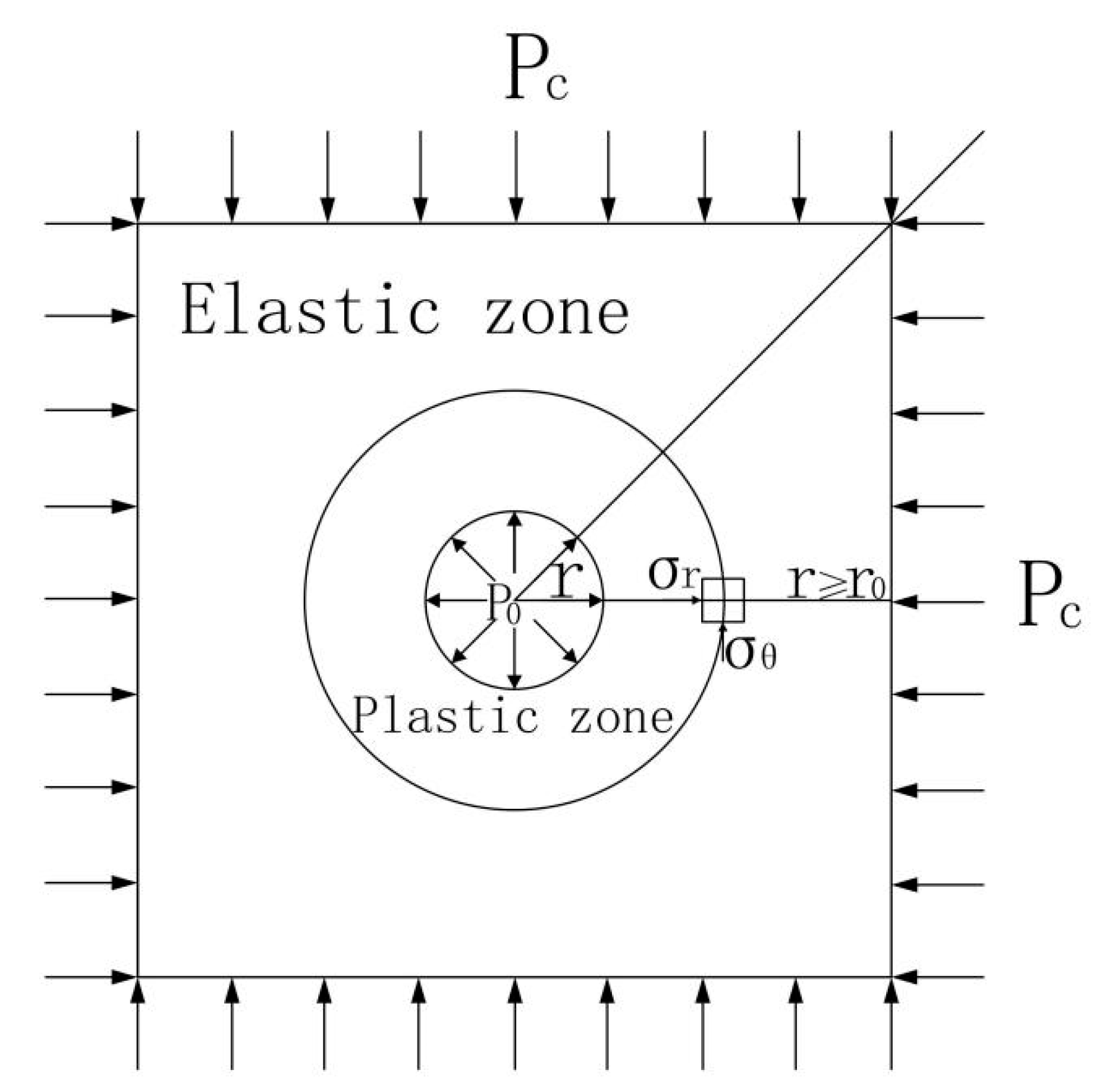


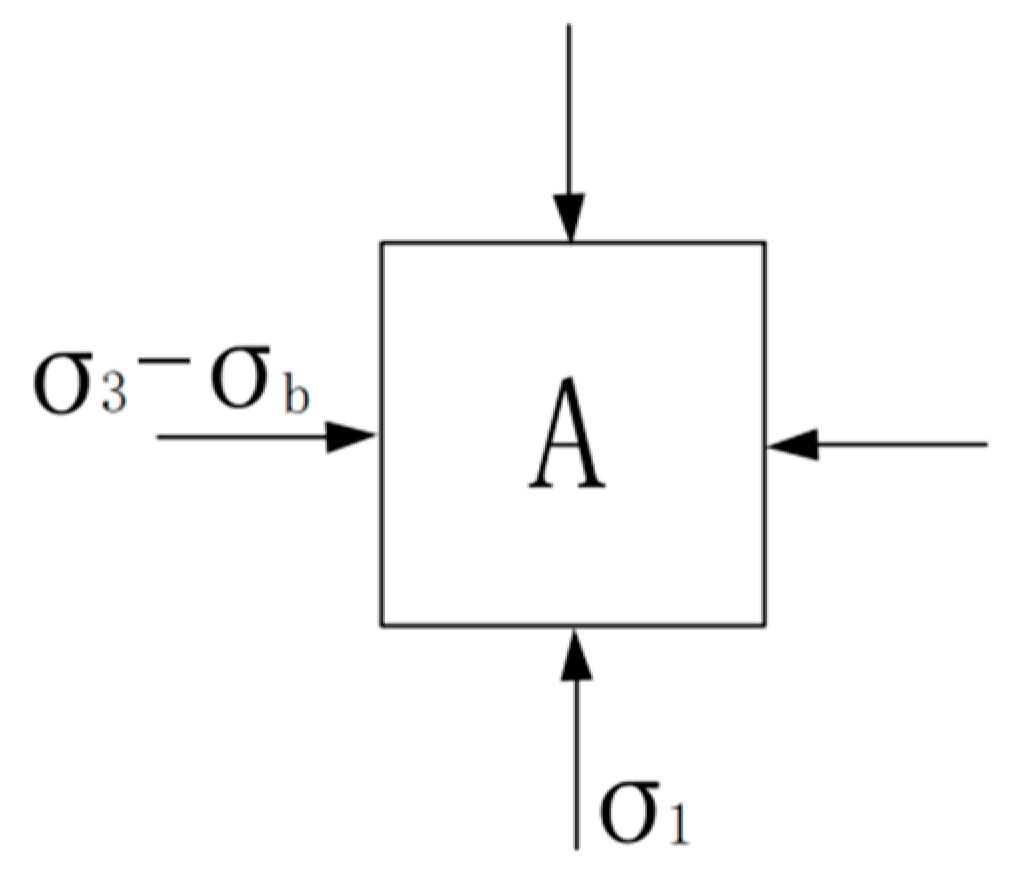
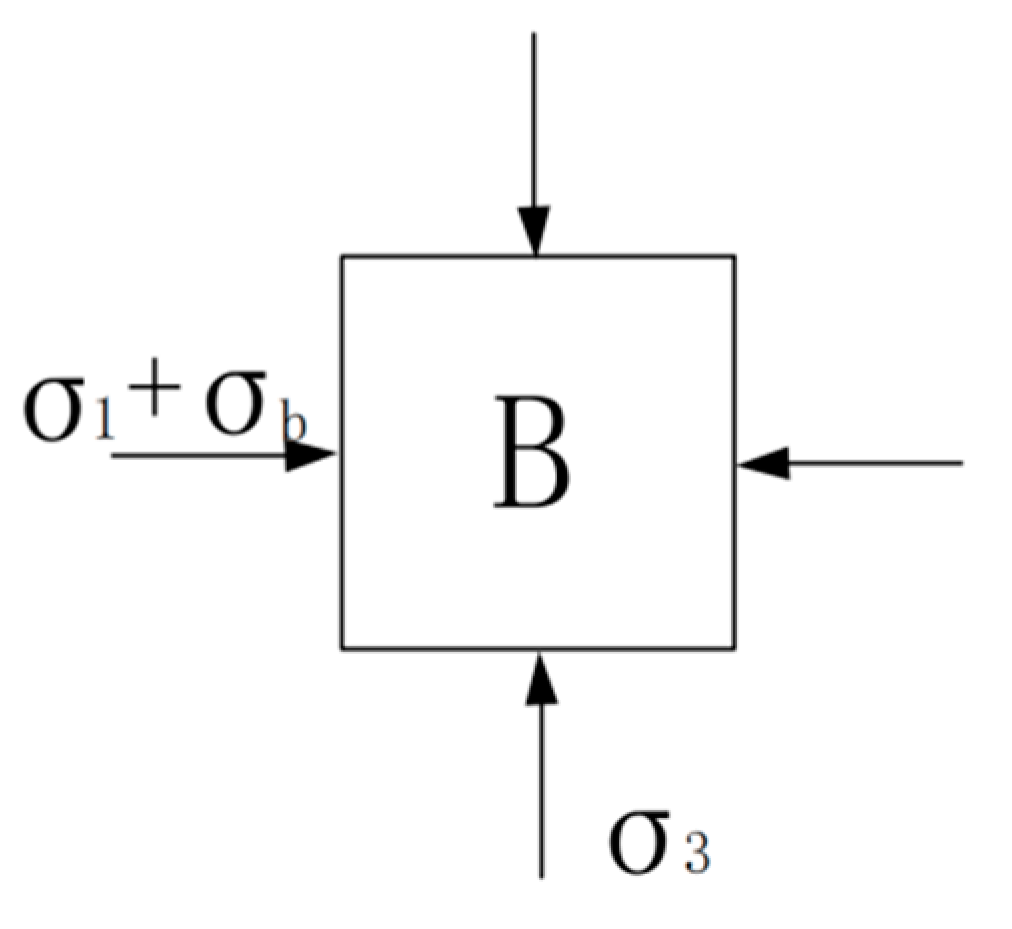
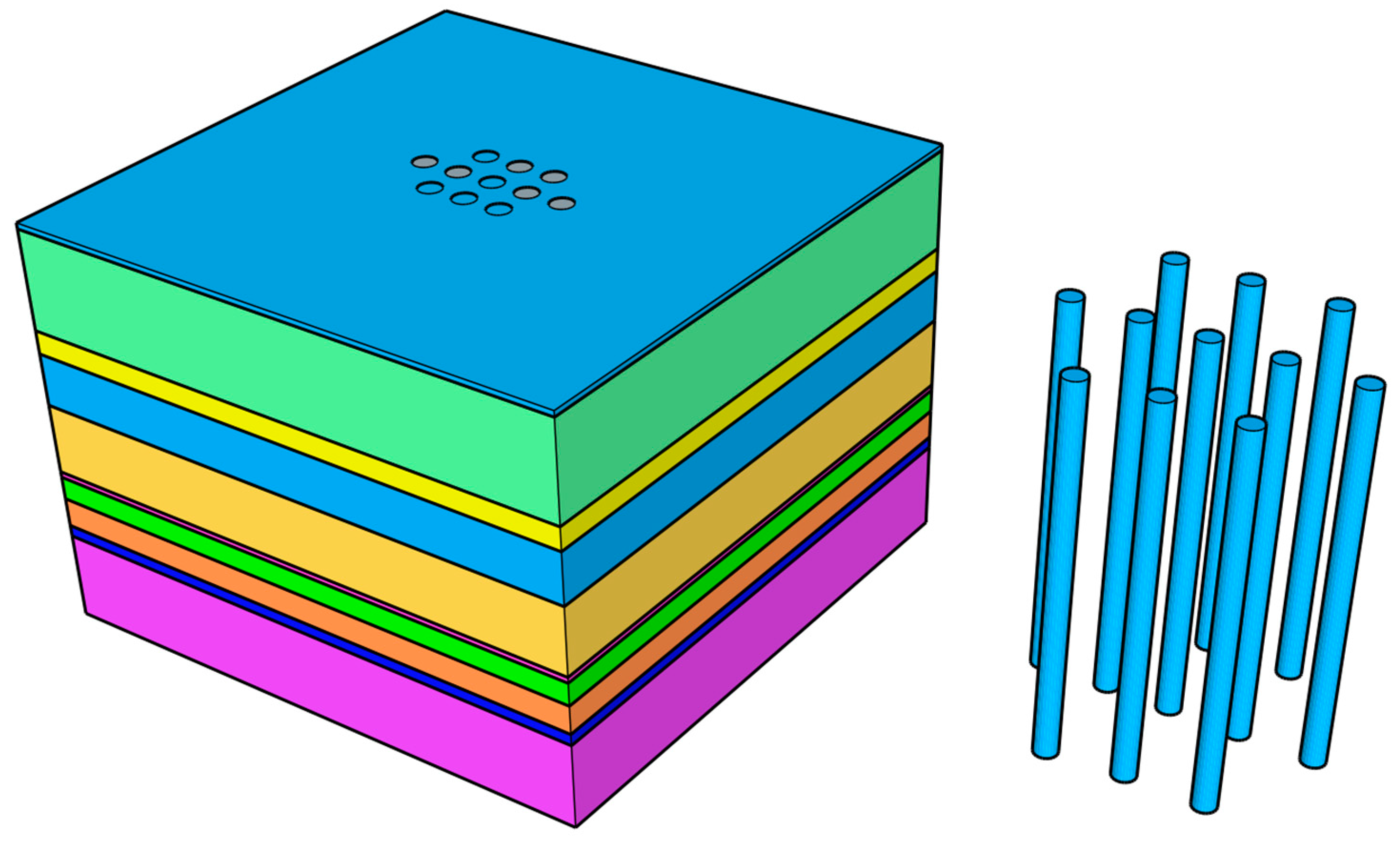
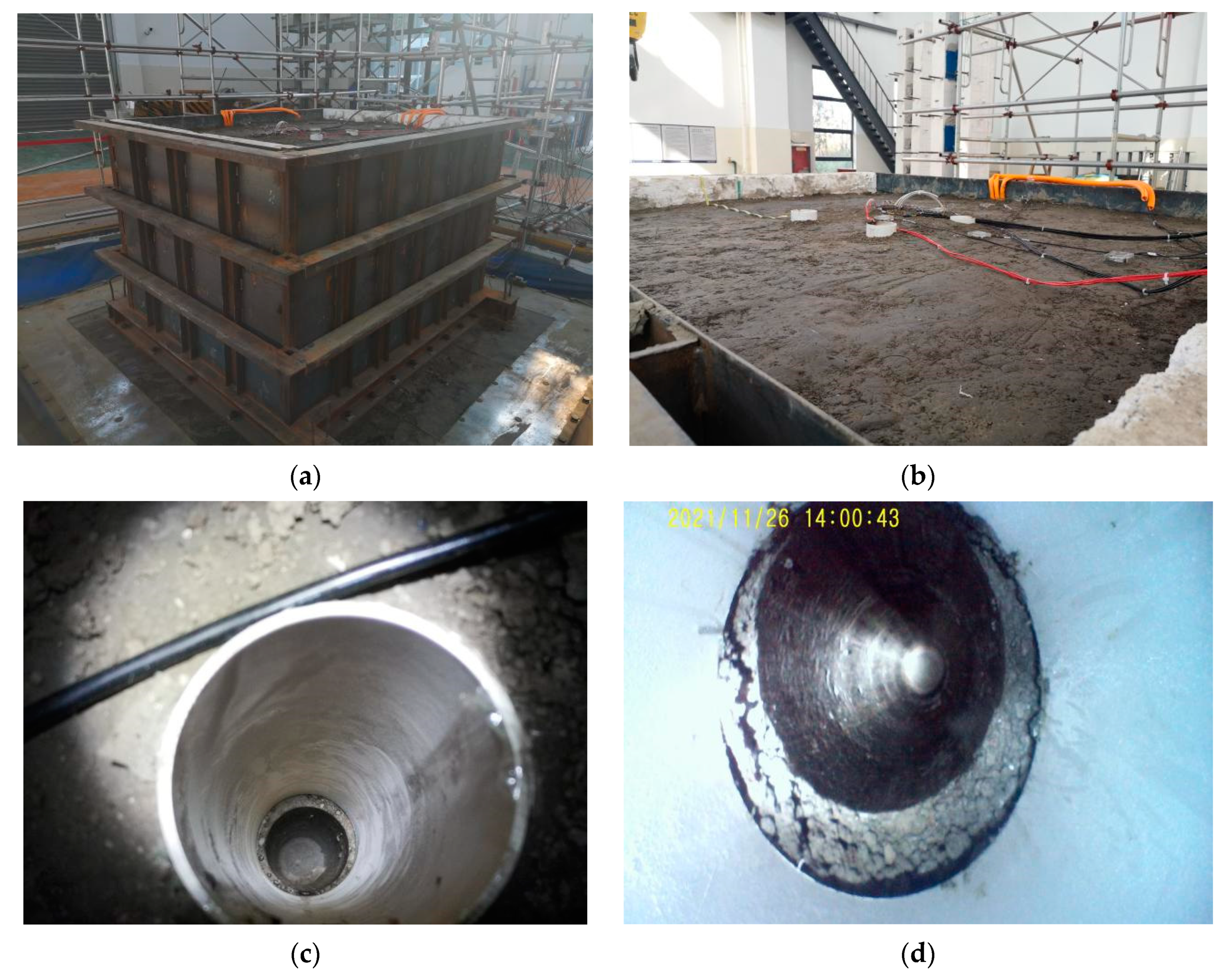

| Soil Layer Number | Layer Thickness (m) | Unit Weight | Compression Modulus (MPa) | Poisson’s Ratio | ||
|---|---|---|---|---|---|---|
| 1 | 1.0 | 16.5 | 8.5 | 10.8 | 2.50 | 0.47 |
| 2 | 17.0 | 17.65 | 10.75 | 13.45 | 3.16 | 0.42 |
| 3 | 4.0 | 17.9 | 11.5 | 8.7 | 3.42 | 0.39 |
| 4 | 9 | 17.1 | 17.4 | 6.65 | 3.03 | 0.42 |
| 5 | 12 | 17.6 | 18.3 | 15.6 | 4.19 | 0.38 |
| 6 | 1.0 | 18.6 | 44.3 | 7.3 | 5.82 | 0.33 |
| 7 | 4 | 19.1 | 34.9 | 14.5 | 6.53 | 0.36 |
| 8 | 5 | 22.5 | 5.0 | 52 | 22.95 | 0.3 |
| 9 | 2 | 25.0 | 7.0 | 57 | 25.72 | 0.25 |
| 10 | 15 | 28.0 | 9.0 | 59 | 35.60 | 0.22 |
| Soil Layer Number | Layer Thickness (m) | ||
|---|---|---|---|
| 1 | 1.0 | 37.9 | −12.0 |
| 2 | 17.0 | 206.5 | 182.6 |
| 3 | 4.0 | 390.5 | 420.8 |
| 4 | 9 | 496.5 | 487.7 |
| 5 | 12 | 698.6 | 978.9 |
| 6 | 1.0 | 809.7 | 1262.8 |
| 7 | 4 | 863.4 | 1334.7 |
| 8 | 5 | 1258.7 | 6450.9 |
| 9 | 2 | 1601.2 | 11693.1 |
| 10 | 15 | 2050.5 | 18161.0 |
| Location | Depth (m) | Comparison | ||
|---|---|---|---|---|
| Bottom of PVC tube | 0.625 | 18.86 | 27.39 | |
| Soil layer under PVC tube | 0.825 | 26.51 | 27.39 |
| Location | Depth (m) | Comparison | ||
|---|---|---|---|---|
| Bottom of PVC tube | 0.625 | 20.83 | 27.39 | |
| Soil layer under PVC tube | 0.825 | 28.48 | 27.39 |
Publisher’s Note: MDPI stays neutral with regard to jurisdictional claims in published maps and institutional affiliations. |
© 2022 by the authors. Licensee MDPI, Basel, Switzerland. This article is an open access article distributed under the terms and conditions of the Creative Commons Attribution (CC BY) license (https://creativecommons.org/licenses/by/4.0/).
Share and Cite
Yang, Q.; Ba, Z.; Zhao, Z.; Peng, X.; Sun, Y. Stability Evaluation Method of Hole Wall for Bored Pile under Blasting Impact. Symmetry 2022, 14, 79. https://doi.org/10.3390/sym14010079
Yang Q, Ba Z, Zhao Z, Peng X, Sun Y. Stability Evaluation Method of Hole Wall for Bored Pile under Blasting Impact. Symmetry. 2022; 14(1):79. https://doi.org/10.3390/sym14010079
Chicago/Turabian StyleYang, Qiuwei, Zhikun Ba, Zhuo Zhao, Xi Peng, and Yun Sun. 2022. "Stability Evaluation Method of Hole Wall for Bored Pile under Blasting Impact" Symmetry 14, no. 1: 79. https://doi.org/10.3390/sym14010079
APA StyleYang, Q., Ba, Z., Zhao, Z., Peng, X., & Sun, Y. (2022). Stability Evaluation Method of Hole Wall for Bored Pile under Blasting Impact. Symmetry, 14(1), 79. https://doi.org/10.3390/sym14010079







